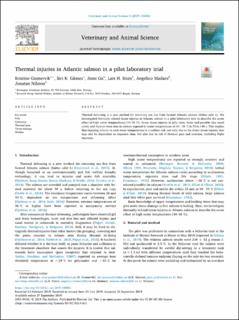| dc.contributor.author | Gismervik, Kristine | |
| dc.contributor.author | Gåsnes, Siri Kristine | |
| dc.contributor.author | Gu, Jinni | |
| dc.contributor.author | Stien, Lars Helge | |
| dc.contributor.author | Madaro, Angelico | |
| dc.contributor.author | Nilsson, Jonatan | |
| dc.date.accessioned | 2020-03-19T07:23:47Z | |
| dc.date.available | 2020-03-19T07:23:47Z | |
| dc.date.created | 2019-12-09T14:40:36Z | |
| dc.date.issued | 2019 | |
| dc.identifier.citation | Veterinary and Animal Science | en_US |
| dc.identifier.issn | 2451-943X | |
| dc.identifier.uri | https://hdl.handle.net/11250/2647463 | |
| dc.description.abstract | Thermal delousing is a new method for removing sea lice from farmed Atlantic salmon (Salmo salar L). We investigated thermally-related tissue injuries in Atlantic salmon in a pilot laboratory trial to describe the acute effect of high water temperatures (34–38 °C). Acute tissue injuries in gills, eyes, brain and possible also nasal cavity and thymus were seen in salmon exposed to water temperatures of 34 - 38 °C in 72 to 140 s. This implies that exposing salmon to such water temperatures is a welfare risk, not only due to the direct tissue injuries that may also be dependent on exposure time, but also due to risk of thermal pain and aversion, including flight reactions. | en_US |
| dc.language.iso | eng | en_US |
| dc.title | Thermal injuries in Atlantic salmon in a pilot Laboratory trial | en_US |
| dc.type | Peer reviewed | en_US |
| dc.type | Journal article | en_US |
| dc.description.version | publishedVersion | en_US |
| dc.source.pagenumber | 8 | en_US |
| dc.source.volume | 8 | en_US |
| dc.source.journal | Veterinary and Animal Science | en_US |
| dc.identifier.doi | 10.1016/j.vas.2019.100081 | |
| dc.identifier.cristin | 1758353 | |
| cristin.unitcode | 7431,14,0,0 | |
| cristin.unitname | Dyrevelferd | |
| cristin.ispublished | true | |
| cristin.fulltext | original | |
| cristin.qualitycode | 1 | |
